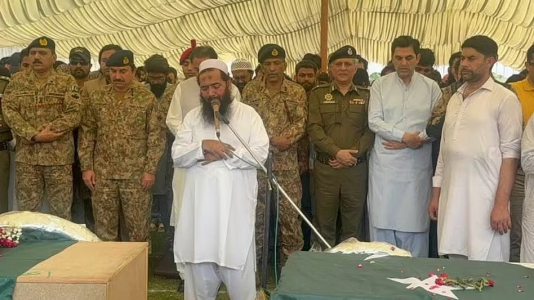ISLAMABAD: Just past midnight on May 7, a low hum of tension filled the Combat Operations Centre at Pakistan Air Force (PAF) Headquarters in Islamabad.
On radar screens, dozens of Indian Air Force (IAF) fighters began clustering to the north, maneuvering with unmistakable intent.
Within minutes, Pakistan’s skies were alive with scrambling fighter jets — including the most recently inducted J-10C aircraft, flown by one of its most storied units: No. 15 Squadron, the “Cobras.”
Nearly a month later, the PAF formally acknowledged what many had speculated — that it was the Kamra-based 15 Squadron that led the charge in shooting down six Indian Air Force (IAF) jets during what’s now considered one of the largest air-to-air engagement in South Asia in more than half a century.
Pilots from Kamra-based No. 15 Squadron expected to be decorated at a formal ceremony later this month
Eighteen of the squadron’s 20 J-10C aircraft took part in the mission, executing a high-risk intercept against a large-scale Indian formation as part of Pakistan’s defensive response.
In a post released by the PAF’s media directorate, the Cobras were hailed for their legacy and professionalism: “From heroic air battles in the 1965 war, where Flt Lt Imtiaz Bhatti downed two Indian Vampires, to Cold War-era vigilance during the Soviet-Afghan War, the squadron has always remained combat-ready… Now equipped with J-10C 4.5+ generation fighters, the Cobras continue to embody precision, courage, and aerial dominance.”
The May 7 confrontation — triggered by India’s launch of Operation Sindoor following a deadly attack in Pahalgam — saw more than 120 aircraft take to the skies from both sides.
According to the Pakistani military’s official account, the six Indian aircraft downed included three Rafales, a MiG-29, a Mirage-2000, and a Su-30MKI — all hit by PL-15 BVR missiles fired from PAF J-10C fighters. Each launch was executed by pilots from the 15 Squadron, who are expected to be publicly named and decorated at a formal ceremony later this month.
A senior PAF official, speaking on condition of anonymity due to the sensitivity of the matter, confirmed: “The pilots involved in the operation will be honoured soon. These are some of the finest aviators in our ranks — and their performance speaks for itself”.
The engagement, insiders say, was the result of a calculated bait-and-counter strategy. With credible intelligence of an impending Indian incursion, the PAF deployed four defensive counter-air formations and monitored over 60 Indian aircraft using its electromagnetic spectrum management systems.
“We fought the battle on our terms,” the official added. “Our kill chain was fully active. When the command shifted, while aircraft were airborne, from ‘Deter’ to ‘Assure Kill, Deny Own Loss,’ the Cobras carried out their mission with precision and control.”
Dawn














.png)

